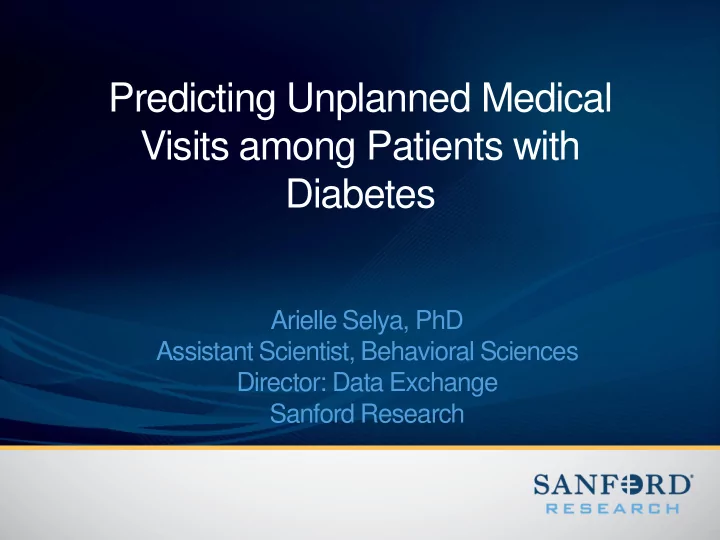

Predicting Unplanned Medical Visits among Patients with Diabetes Arielle Selya, PhD Assistant Scientist, Behavioral Sciences Director: Data Exchange Sanford Research
Diabetes • High blood glucose – Type 1: no insulin production – Type 2: insulin resistance • 9% of U.S. population • $245 billion annual costs [1] – $176 billion in direct medical costs [1] Source: https://gis.cdc.gov/grasp/diabetes/DiabetesAtlas.html
Effects of Diabetes • Hyper/hypoglycemia [2] • Patients have • Vascular complications [2] many unplanned – Cardiovascular disease medical visits [4] (CVD) – Nerve damage – Kidney damage – Eye damage • Infections [3] – Soft tissue – Respiratory tract – Urinary tract
Risk Prediction Challenges Hypothetical: Perfect Hypothetical: Random prediction prediction Unplanned Visits + Unplanned Visits
Risk Prediction Challenges Actual Data • Small but statistically significant difference (88.3 vs. 87.5, p =.005) • Statistical differences do not necessarily indicate predictive ability ! Unplanned Visits + Unplanned Visits
Machine Learning for Risk Prediction • Classification task (any vs. no unplanned visits) – Linear and quadratic discriminant analysis – Support vector machines (SVM) – Artificial neural nets (NN) • Relative to status quo – Logistic regression analysis – LACE Index for 30-day readmissions
Training & Evaluating Classifiers • Cross-validation testing – How well did the classifier learn patterns that are truly diagnostic of a category/outcome? • Confusion matrices Predicted Predicted class: 0 class: 1 Actual class: Correct False alarm 0 rejection Actual class: Miss Hit 1 • Average prediction accuracy: mean of correct rejection and hit rates
Data from Sanford Health • EMR data 2014-16 • Predictors: – Age • N=63,245 patients: – Blood pressure – Age 18 or over – Number on “problem list” – Diabetes diagnosis – Number of prescriptions – Zip codes in MN, ND, – Body mass index (BMI) SD – Cholesterol (HDL, LDL) • Unplanned visits – A1C – 4 separate types – Ranked smoking status – 54.7% had ≥1 unplanned visit
Risk Prediction Results Best-case classifier Logistic regression (radial-basis SVM) Prediction: Prediction: Prediction: Prediction: No visits 1+ visit No visits 1+ visit Actual: 60.5% 39.5% Actual: 67.8% 32.2% No visits No visits Actual: 29.8% 70.2% Actual: 34.1% 65.9% 1+ visit 1+ visit Average: 65.4% Average: 66.9% (+1.5% points) LACE index for 30-day readmissions: 66.3% hit rate; 53.3% false rejection rate = average 59.8%
Impact of More Accurate Prediction • For the broader population (not restricted to patients with diabetes): – N=379,870 people with 1+ unplanned visit – Using SVM over regression correctly identifies N≈3039 people at risk (≈10,000 visits) • Analyses of cost were not feasible
Clinical Implications • Can’t conclude causality (from classifiers or regressions) • Separate treatment from prediction? • How to extract clinical implications? – E.g. what predictor variables, if modified, would lower unplanned visits? – Remove patients with certain ranges on modifiable variables, and re-run models
Variables’ Impact on Prediction Accuracy Restricted variable New prediction Change in accuracy range accuracy BMI < 30 (N=15,885) 65.9% -1.0% BP < 120/80 (N=11,996) 65.0% -1.9% No current smoking 65.8% -1.1% (N=38,370) LDL < 130 (N=39,384) 65.8% -1.1% HDL > 50 (N=30,058) 65.1% -1.8% A1C < 6.5 (N=13,857) 66.2% -0.7% High levels of BP and HDL were most informative for predicting unplanned visits
Next Steps • Refining the predictive model – Adding more variables and refining the model – Validate the model with forthcoming data – Generate recommendations for clinical targets • Clinical implementation at Sanford – Aggressively target strong predictors (BP, HDL, smoking) – Prospectively look at unplanned visits (identifying causality) – Automated system for flagging high-risk patients
Acknowledgements Collaborators Funding • Eric L. Johnson, MD, • Sanford Data University of North Collaborative grant, 2017 Dakota • NIH NIGMS • Emily Griese, PhD, 1P20GM211341-01 Sanford Research • Benson Hsu, MD, Sanford Health
References 1. American Diabetes Association (2013). Economic costs of diabetes in the U.S. in 2012. Diabetes Care ; 36 (4):1033-46 doi: 10.2337/dc12-2625. 2. Centers for Disease Control and Prevention (2014). National Diabetes Statistics Report: Estimates of Diabetes and Its Burden in the United States. Atlanta, GA: U.S. Department of Health and Human Services. 3. Standards of Care. American Diabetes Association. Diabetes Care 2016 Jan; 39 (Supplement 1): S1-S2. 4. Washington RE, Andrews RM, Mutter R (2010). Emergency Department Visits for Adults with Diabetes. Statistical Brief #167, Healthcare Cost and Utilization Project (HCUP) Statistical Briefs. Agency for Healthcare Research and Quality (US), Rockville (MD). 5. Hofer SE, Miller K, Mermann JM, et al. (2016). International comparison of smoking and metabolic control in patients with Type 1 Diabetes. Diabetes Care, 39(10):e177-e178. 6. McDonald HI, Nitsch D, Millett ERC, Sinclair A, Thomas SL. (2014). New estimates of the burden of acute community-acquired infections among older people with diabetes mellitus: a retrospective cohort study using linked electronic health records. Diabet Med, 31(5):606-614.
Most Common Diagnoses in Unplanned Visits Smokers with diabetes Nonsmokers with diabetes Diagnosis Frequency Diagnosis Frequency 6.6% ( N =4109) 5.4% ( N =8856) R10.xx: Abdominal and pelvic R10.xx: Abdominal and pelvic pain pain M54.xx: Dorsalgia 6.1% ( N =3750) M54.xx: Dorsalgia 4.3% ( N =7099) R07.xx: Pain in throat and 3.6% ( N =2252) R07.xx: Pain in throat and 4.3% ( N =6971) chest chest M25.xx: Other joint disorder, 3.4% ( N =2114) M25.xx: Other joint disorder, 3.2% ( N =5175) not elsewhere classified not elsewhere classified 3.4% ( N =2085) 3.1% ( N =5092) M79.xx: Other and M79.xx: Other and unspecified tissue disorders unspecified tissue disorders L03.xx: Cellulitis and acute 2.3% ( N =1453) R05.xx: Cough 2.8% ( N =4547) lymphangitis E11.xx: Type 2 Diabetes 2.1% ( N =1314) L03.xx: Cellulitis and acute 2.2% ( N =3526) Mellitus lymphangitis R05.xx: Cough 2.1% ( N =1298) J40.xx: Bronchitis, not 2.1% ( N =3422) specified as acute or chronic J40.xx: Bronchitis, not 2.0% ( N =1265) J02.xx: Acute pharyngitis 2.0% ( N =3222) specified as acute or chronic G43.xx: Migraine 1.9% ( N =1197) R51.xx: Headache 1.8% ( N =3.14)
Recommend
More recommend